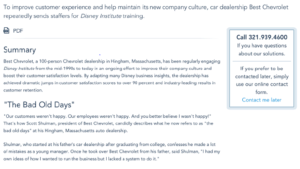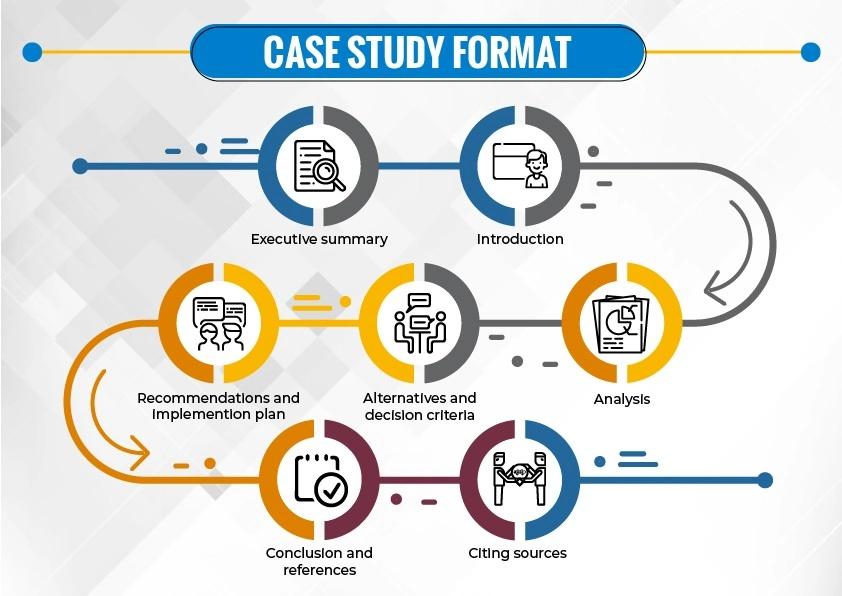Case Studies are a powerful weapon to show proof of credibility to your target audience that you are the best. When you portray your expertise and bring your success stories to light by accurately knowing how to write a case study in a conversion-oriented manner, converting leads into customers becomes a cakewalk.
A case study refers to the research methodology, which is commonly applied for social sciences.
It refers to the strategy which uses empirical inquiry to investigate a phenomenon. Case studies always involve in-depth investigations into an event, group or individual.
While talking about the significance of Case Studies, Seth Godin says-
If you wait until there is another case study in your industry, you will be too late!
There are several ways of writing a case study.
You could be illustrative where you describe events; exploratory-involving investigation, cumulative where you make comparisons and critical where you examine one subject on cause or effect.
In this article, you will discover the following:
- How to write a Case Study?
- Case Study Examples
- How to write a Case Study Report?
- How to write a Case Study Example?
- What is a Case Study?
A case study is a form of content that is published by a company to outline their success or discuss how they solved a real-life challenge of a client. These case studies can include analysis of a campaign, a project, or a company.
Download Detailed Brochure and Get Complimentary access to Live Online Demo Class with Industry Expert.
A case study spots a particular condition, ideates recommendations, and implements certain actions that produce an outcome. This outcome can be either a success or a failure. The case study may sometimes even include further analysis of the achieved success or failure.
A case study may include:
- Observations
- Psychological Tests
- Interviews
Why Should a Blogger Know How to Write a Case Study?
Writing a case study has several benefits.
Besides being one of the most effective methods out there, it is also an effective method to market yourself as well as show a would-be client that you have a successful track record of dealing with their issues.
The list of benefits, writing a case study offers:
1. An Instrument to Bring the Product to Life
A blog or advertisement can never tell the full story of your product or service. This is especially true in the case of complex products. When you take advantage of storytelling to illustrate how your product offers values to customers, you make clients understand the product’s usefulness and worth. Thus, after you launch a new product, you can certainly create a case study on the journey of the product.
2. Bestows a Peer to Peer Effect
You would value the experience of someone who is in the same boat as you, right? This same principle works in the peer to peer effect. Though a case study if for a company, its main focus is on a past client, their challenges, and overcoming that challenge. Therefore, it is the best tool to persuade your leads.
3. Positions Your Service as the Best
When you show how efficient your product is in solving client’s issues through the case study, you directly position the brand as the best solution out there.
4. Sets you Apart from the Competition
Everyone is writing blogs to educate or persuade the target audience. By going the case study route, you set yourself apart from the competition. Moreover, it is much harder to know how to write a case study, but at the same time, it is more effective than blogs.
5. Provides Real Evidence of your Claims
There is no shortage of companies who make tall claims. However, what is often found lacking is the evidence that serves as proof for the tall claims. This is where the usefulness of case studies comes in.
Case Study Examples
Below you can have a look upon two case study examples that will you learn and master how to write a case study in a productive fashion.
How to Write a Case Study Example 1

Best Chevrolet was a Chevrolet dealership in Hingham. This automotive case study comes from a well-known brand, Disney. The case study is a masterpiece where Disney cleverly brings out its corporate training programs to light.
If you go through the case study, you can see that Disney has portrayed their expertise in improving customer and employee satisfaction for Best Chevrolet in a very clear cut manner.
How to Write a Case Study Example 2

Another great way of creating case studies is with videos. Apple makes use of this approach. They have utilized a combination of both short writings and videos to market themselves.
You can check out their unique case study approach, where they have highlighted how Apple apps and technologies are improving different businesses.
Case Study Format
The famous Case Study Format includes can be of different types. Let’s look at some of the case study format options that you can explore:
- A Website Page
- A Downloadable PDF
- A PowerPoint Presentation
- Video
Different elements that a Case Study Format should include are-

- Title or Headline
- Executive Summary
- The Subject
- Problem or Challenge
- Solution
- Results
Key things you need to pay attention to before writing a Case Study are-
(i) First, you need to determine the type of your case study. You also have to choose the design and style that you want to present to your audience. For example, illustrative case studies are used by corporations to present what has been done for clients. Educative institutes prefer cumulative and critical case studies, whereas legal corporations use exploratory case studies to provide evidence and facts.
(ii) Once you have decided on your angle, you need to outline what your research is about and where it is placed. Begin your inquiry in the library or on the internet to dive into the topic. Narrow your research down to one specific problem and dig out as much information as you can about it.
(iii) Read material that has already been published about the topic you have chosen. Read everything essential about your case site. You may discover there is a real issue that needs to be solved to there might be some new problem that you find out on your own. Keep reviewing sample studies that might be similar in style to get a vague idea of format and composition.
(iv) Request data and material from significant people. You might want to interview knowledgeable individuals for credibility and proper presentation of your study. Organize all the data that you have collected. You cannot include everything, so make sure that you have the critical things filtered out.
(v) Experts in a specific field or customers who have made use of goods, tools, or services will provide excellent information on your case study. Contact people who have been in contact with your site or topic directly/indirectly gather as much information as you can about the subjects of your research.
(vi) Ask similar questions to multiple people. This will ascertain that you get different perspectives on subjects that are similar. Ask for data and materials from the subjects of your study. This adds credibility to your work and helps in the presentation of your study. Concentrate on the matter, which is most important, and make sure you do not beat around the bush.
Effective Tips to Know How to Write a Case Study
1. Include a minimum of four sections- introduction, background, the rationale of the case study, presentation of data along with the conclusion.
2. Include background information about your study site. Make sure that you can communicate why your problem needed to be addressed in your study.
3. Keep the introduction very clear. The main problem and issues should be laid out in the very beginning.
4. After you have given the problem and analyzed it, make sure you provide some solutions to the issue at hand. If no settlement is needed, provide a perspective of the subject’s future.
5. You must mention your references for credibility. If there are terms particular to your study, which people ordinarily wouldn’t understand, then add an appendix.
6. Make sure that you have identified the key issues and problems in the case study.
7. Include a well-formulated thesis statement. Summarize the outcome of the analysis and don’t keep it more than 1-2 sentences.
8. Keep good background information; focus on the most critical issues and the relevant facts.
9. Make sure that you have demonstrated the research of your case study well.
10. Provide good solutions which are realistic, about the problem, as it makes your case study highly relevant and engaging to your target audiences.
11. Discuss and determine the specific strategies that are needed to accomplish a particular set of actions to solve the problem.
12. Ask only open-ended questions when you conduct your interview to foster discussion, as this will help you get the right idea for your case study formation.
13. Ask your study participants if you have their permission to disclose their names and information. Maintain their anonymity if you find that they are unwilling.
How to Write a Case Study Report in 6 Steps
Above, we mentioned some formats for case studies. However, the most integral element in a case study is its content. Some mandatory fields for case study content are the title, subject, the challenge, the solution offered, results, and an executive summary.
Now, let’s understand how to write a case study report & get into the different steps involved in the case study writing process.
1. Decide Who/What you Want to Write About
This is the first step that has a great influence on how the case study is produced. You have to decide who or what the case study is going to talk about. Most companies go with clients. However, the subject can be your company as well.
You can go with a client-based case study if your customer bases frequently use your product/ service, customers have a positive experience to share, or they have chosen you over your competitors. This information can be easily obtained from the company’s sales department.
2. Get Permission to Proceed with the Story
If you are writing about your company, then it’s well and good. However, if you plan on choosing clients as your subject, then it’s recommended that you get their permission first.
How to go about it? First, draft a permission letter. The permission letter should contain what information or stories you mean to include in the case study. Also, highlight the benefits or perks the clients will get if they help in the creation process.
For this, you may need to use a legal form to use the client’s information. It is best to consult your legal team to decide if you need to have a legal release form.
3. Draft and Send a Questionnaire
After you receive a green signal from your client, you can proceed with creating an introductory questionnaire.
Some questions to include in the questionnaire are:
- Discuss the problems that you faced before the product or service
- What made you choose us over our competitors?
- How did our product/ service solve your problem?
- Are you willing to share some data with us to display your success with the challenge?
- What are your major goals as a company?
These are some of the basic questions which can be further tailored to suit your needs.
4. Arrange for an Interview
The introductory questionnaire was to help you draft the main questions that are going to be included in the interview. Asking the right questions is extremely important to create a high-quality case study. Therefore, study the answers from the introductory questionnaire carefully to create some insightful and relevant questions.
Let’s discuss some questions that you should include in your interview.
First, you need to have a good grip on your subject. Therefore, include questions that give you information on the industry they are in, the duration of their product/service use, and how big is their team.
Elaborate on the challenges they were facing before they contacted you. You can ask the following types of questions:
- When was the problem first detected?
- Did you encounter the problem suddenly or it was occurring for some time?
- How did you tackle the problem before coming to us?
Now, come to the questions that highlight your good qualities and made the client decide to go with you. Some of these can look like:
- What factors that made them choose you?
- Which competitors did they consider before choosing you?
- What influenced their decision?
Further, also work on a section that focuses on how your product helped them solve the problem.
5. Write Down the Case Study
After getting all the answers to your questions, it is now time to write the case study.
(i) Title
Give a catchy title. The title and the subheading should inform who the client was, what the problem was, and how it was solved.
(ii) Executive Summary
The section should not be longer than two or three sentences. The story of the challenge that the client faced along with the data to prove the success are two things that should be included.
(iii) Subject
In this section, you need to talk about who is your client, what services they offer, and how long they have been associated with you.
(iv) Problem
Here you are going to list down the client’s top 3 issues and how they were handling those issues before coming to you.
(v) Solution
This is the most important part of the case study, which has the most impact on future customers, so write it well. Include the solutions you offered to the client, the product they used, and the changes that were produced after the product use.
Remember to add the links to your company and product here. Additionally, add some pictures of the product being used.
(vi) Result
The last section of the case study should include details on what outcome your product produced for the client. Include some data and metrics to demonstrate the triumph.
6. Promote the Case Study
The most important task after writing a case study is promoting it.
People need to see the wonderful contributions you have made to your client’s business. This can be done by dedicating a page on your website to portray your case studies or including them in your Email Marketing.
Case studies can also be used during marketing campaigns.
Final Thoughts
The last and the most crucial stage of your case study is editing and proofreading.
Make sure that you have asked open-ended questions in the survey. See that you have mentioned the names of the people you have interviewed long with other case participants.
Proofread your work to make sure there are no errors.
This was a comprehensive guide on how to write a case study. Incorporate the tips mentioned here to create an amazing case study that converts.
Enrolling in an SEO Course will guide you on how to write a case study for your blog in the most effective way possible.
What according to you is the most important factor of a best-rated case study? Update us in the comments below.



















